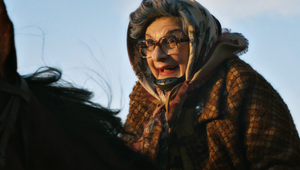
How Natalie Rae Portrayed a ‘Future Canada’ that Transcends Clichés for lululemon’s Olympic Collection
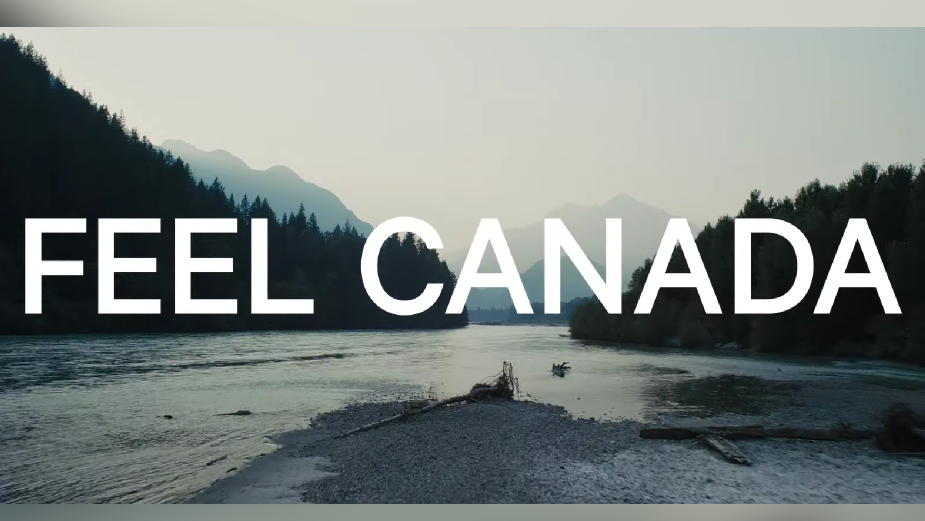
American-Canadian athletic apparel company lululemon, with headquarters based in Vancouver, is a company that’s proud of the influence and connection it has with Canada. With the winter Olympics taking place last month, the sports clothing company partnered with Team Canada for a collection that celebrates the Canadian Olympic and Paralympic teams, as well as the evolving idea of what it means to be Canadian.
Agency Droga5 and its Canadian co-CCO Tim Gordon collaborated on the creative for the film, while Object & Animal's director Natalie Rae - a fellow Canadian - was enlisted to direct the spot after creating a treatment that turned lululemon’s Olympic apparel into a portal to ‘future dreamscapes’ and memories of Canada. The film includes breath-taking natural landscapes, heartfelt personal stories and emotive dance sequences, all with the intention of representing a free-flowing national identity that has been the subject of clichés and is often overlooked in spite of its diversity and dynamism.
The spot also includes footage filmed by Natalie Rae’s production company OPC with the Saugeen indigenous community in Southampton, Ontario - sharing their ‘Feel Canada’ messages and connecting the concept of ‘Canadian-ness’ back to nature and the winter time. Another significant component of the spot is the soundtrack, which features a multitude of quotes and voices from prominent Canadian figures throughout history, including Leonard Cohen, Catherine O’Hara and David Suzuki.
To discuss the process of writing the spot, working with Olympians and their intimate stories and capturing the ‘tactile memories’ of Canada, LBB’s Ben Conway spoke to director Natalie Rae.
LBB> When did Droga5 approach you to work on this spot? How closely did you work with them on the creative?
Natalie> The Droga5 team approached me in early June 2021. lululemon’s Team Canada Olympic/Paralympic collection was inspired by transformation and the natural details of Canada’s landscapes. So Droga5 had the initial thought of drawing visual parallels between the collection, the Canadian people and the abstract textures of Canadian landscapes. This was a good jumping-off point and was a really seamless and integrated way to bring the concept to life. Working on my treatment, I came up with the idea that touching an athlete’s parka would be like opening a portal to all of that athlete’s memories of what it feels like to be Canadian. I wondered what it would be like walking into your hotel room during the Games and putting that jacket on for the first time. How could we make a film that allowed people to viscerally feel Canada? Droga5 were very trusting and supportive of me guiding the writing process for the idea, and together we crafted the natural textures, the Team Canada clothing and the past memories and future ‘dreamscapes’ of Canada.
Droga5 co-chief creative officer Tim Gordon is Canadian, so there was a strong passion and determination for what this film could be (no pressure!). It was nice that he reached out on a personal level early on in the process to form a collaborative vision.
LBB> What does it mean to you to direct a spot that aired during the Olympics and represents Team Canada, as well as the nation more generally?
Natalie> It’s an incredible honour. I’ve always identified as, and been so grateful to be, Canadian. It’s with nostalgia and pride that I look back on growing up in a place of such wonder and natural beauty. It’s also a place that needs to keep looking inward, to hold hands with the past while reaching for the future in order to reach its full potential. It’s very young. With all the passion I have for the country, I’d love to see Canada evolve into the powerful example of dynamic diversity it can be. Without pointing out the issues, I tried to paint a future Canada that’s coming into itself.
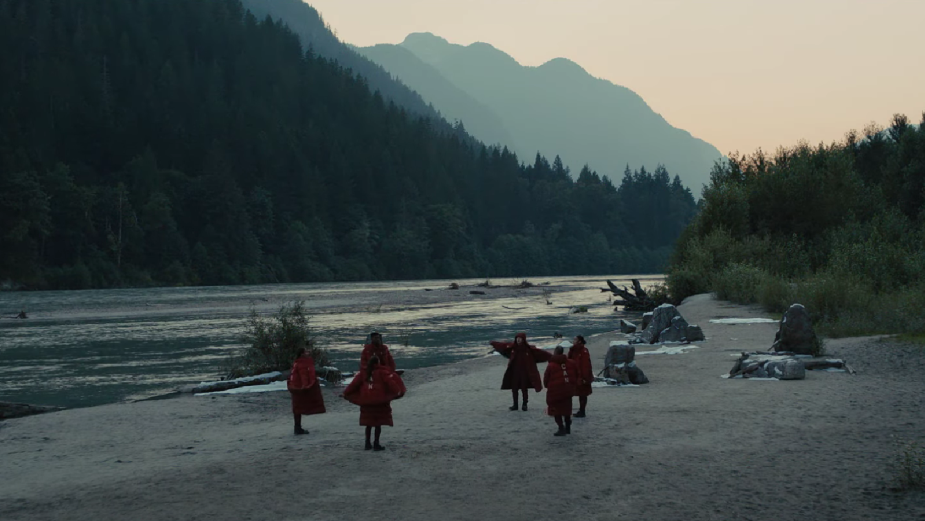
LBB> The spot is about transforming perceptions. How did this influence your directing and ideas for the spot and how did you tie this into the Olympics and Paralympics?
Natalie> We wanted to transcend the clichéd world of Canada that’s prevalent within our own media and across the world. We’re not all these quiet, friendly people who say sorry, live in the snow, play hockey and eat maple syrup. We are world-class artists, powerful activists, people who are developing cutting-edge sustainable design and a culture that’s incredibly rich and diverse.
Seeking to redefine the visual language of Canadian rhetoric, I wanted to bring more style and unexpected elements into the natural world, give more grit to the personalities and show more of the progressive and collected spirit that exists in Canada. I was always looking for unexpected casting and actions to bring to the scenes. With the athletes, we also wanted to look into the past and explore the personal moments and the struggles that shaped them. How could we see our athletes as relatable humans? I also used the athletes' ideas, their memories and ‘feels’ to inspire the mosaic of images so they could feel like it was a representation of the Feel Canada they experience on Team Canada.
LBB> You captured some of the winter footage at Saugeen First Nations in Southampton, Ontario, with Tim Myles. Could you talk us through this process and experience? How was it working with Jennifer Kewageshig?
Natalie> This was a very important aspect of the film for us - not just to throw into a casting spec but to really approach this like a documentary and have indigenous director Tim Myles bring another layer of authenticity to the shoot via his relationship with the community. He worked with Sophia Smith, who also was the second-unit director of the summer shoot. They are both fabulous.
My Canadian production company, OPC, has been working with various indigenous groups and filmmakers. They introduced me to Tim, who has made some projects within the Saugeen community. It was such a lovely experience to learn more about their culture and also let them take the lead in what they wanted to capture. It was important for all of us that indigenous Canadians were captured in an authentic way. They opened up their homes and families to share stories and their rich spirits. Tim and Sophia went and quarantined in advance, then spent an entire week meeting with the family members to get to know them and learn about their day-to-day life, sports they were interested in and how they wanted to be part of the Feel Canada message of the film. From there, we selected different activities and locations around the reservation but always sought to keep the approach loose and spontaneous. We shot on 16mm film to have more of a home-video type of approach, letting the family members determine their own actions. We were lucky there was a snowstorm while we were there! The family’s wisdom about learning from nature and being connected to nature was able to shine through, as we saw winter coming in the film, showing another way Canadians revel in their ability to grow strong through the winter.
Jennifer Kewageshig is a force of nature. She’s the warmest woman, who can make you laugh, and also such a rich elder that she just makes you want to be a better person when you talk to her. She opened up about her family, her motivations, her late mother - her strength came through in her vulnerability in sharing so deeply with us. The Saugeen part of the film took up almost a minute in my first edit! I couldn’t cut it down - it was so beautiful and honest and like nothing I’d really seen that close-up before.
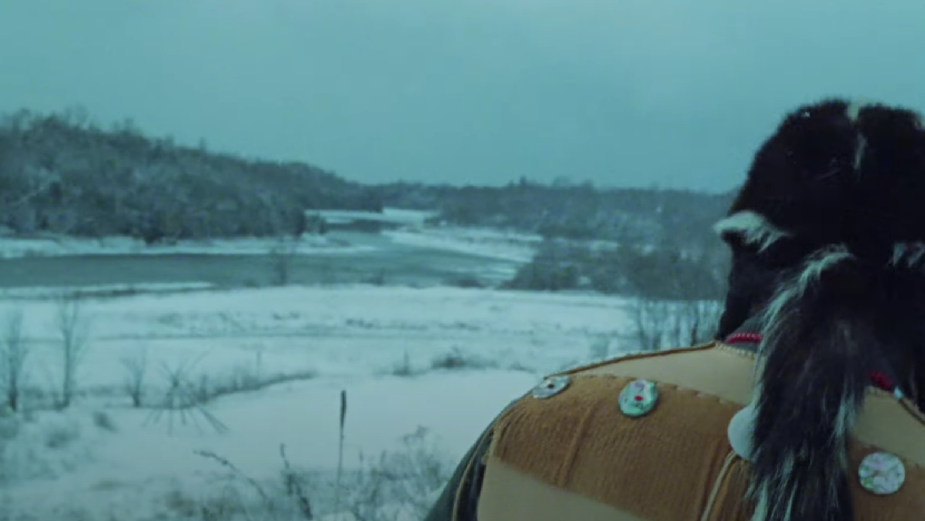
LBB> How was it to direct the Olympians/athletes?
Natalie> They were all amazing—so lovely to work with, professional and detail-oriented. You wouldn’t expect anything different from Olympians! They all were able to translate their unique personalities into the film. It was beautiful hearing how each one had been shaped in different ways by their experience of Canada. Dawn and Piper not being born in Canada, but sharing how it really defined their growth as they became athletes, was so nice to hear about. Everyone had this common feeling of Canada feeling like home, no matter where they were from.
One moment that was so cute was when Dawn requested the choreographer's contact information, as she enjoyed the dance scene so much! She might start working with him!
LBB> How did the various iconic Canadian voices influence the piece?
Natalie> Droga5 had a research team pulling hundreds of quotes from various prominent Canadians. The selection was overwhelming and inspiring. We went into the shoot with a story arc and quotes we liked. We knew it would have this very poetic, layered feeling, but it was mostly in the edit that we started placing in certain quotes. It was the strong words of Catherine O’Hara, Leonard Cohen and David Suzuki, for example, that brought our story to the next level when we put everything together.
LBB> How significant were the sound and music for this spot?
Natalie> We recorded sound on set for authenticity and were always looking for ways to heighten the shots. The song was the idea of my editor, Ben Jordan (Work Editorial), who put it in the first cut and it stuck. We all loved it and kept working with it. Once we had all the pieces, Ballad did an amazing job layering and mixing in the quotes and sound design in an emotional way.
LBB> Droga5 said this about the campaign: “We invite people to Feel Canada in a new way—a country that’s more than just snow and nice people… a mosaic of different landscapes, cultures, perspectives and walks of life.” How did you go about showing this in the film?
Natalie> We were on the same page with our vision for the Canada we wanted to paint. For every detail, we looked for originality, diversity and an unexpected way to see something Canadian - yet also with a balance to relate to it. Through casting, location scouting, the choreography and way the camera moved, and the decision to shoot on both film and Alexa, we aimed to strike that balance of style vs naturalism and nostalgia vs the future. Casting is always at the heart for me - finding real Canadians who aren’t actors, people who have stories to tell, people who have resilience on their faces. I’d ask myself, “How do we normally see this type of person or athlete? Then let’s shoot the opposite.”
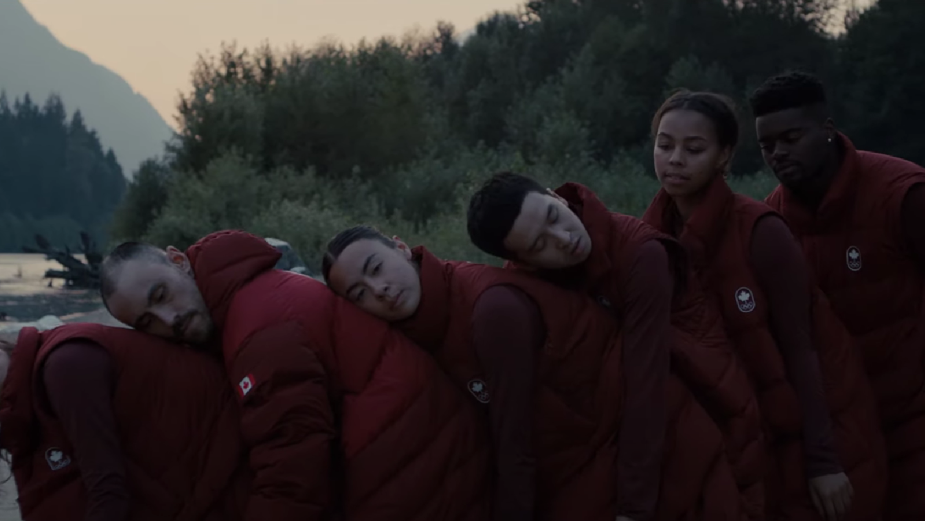
LBB> The film includes a wide variety of different locations and cast members, all doing different activities at different times of the day in a fast-paced montage. How many shoots were there for the film, and how did you combine so many different things into one spot?
Natalie> I wrote a very long and detailed script to start with. The intro has Dawn going into her hotel room, then the parka taking her back to her childhood memories and photos of her deceased parents - the moments that got her here. Then we did the same for Liam: we meet present-day Liam, he touches the jacket and we move through some of his memories as he grew comfortable being a para-athlete in a small town where there was no one like him. From there, we started to weave the athletes with our string of dancers running behind them, like they were the thread through the country. Through different landscapes and cities we have a through-line, building into Dawn being on the river with all the dancers in the jackets - the vision of the future of Canada coming to life in her head all at once.
Then we cut back and reveal her alone again in the hotel room and realise this was all her ‘Feel Canada’ experience, triggered by touching the parka. As for all the life/action/memories, it was a combination of maybe 50% shots listed and 50% letting moments happen. The filter for these shots that I told my second-unit team was: “How can you shoot it in a way that connects it to touch?” Those tactile, sensory memories were the core of the approach. Brushing sand off your scraped knees, rain on your face, losing your breath blowing up an air mattress - things that remind you of your Canadian experience. Droga5 was amazingly trusting of that, so once we had all the specific athlete shots covered, we were open to the other shots of Canada being more spontaneous and real. Once we had our cast, often the actions came more from them than from us.
LBB> How involved were you in the edit process? What directions did you give the editor(s), and what did the edit add to the film?
Natalie> I was very involved in the edit. Ben Jordan took my shooting script and did an incredible job weaving so much footage into an amazing first cut. It’s rare you feel something right off the top, and we all did. He is great with music and story. We wanted to make sure it didn’t feel too vignette-y and random, so we tried to develop chapters in the film. This film, stitching together so many elements, could have gone so many ways. But Ben and I were aligned on the notion that the emotion and the idea of challenging what people think of Canadians were key. We had to be really hard on what to use with boat-loads of footage. If a shot wasn’t serving the overall arc, it needed to go. If a shot didn’t work musically, it could go. If a shot wasn’t making people think, it could go. We edited this on and off for almost six months!
LBB> The shots with the dancers wearing the jackets are truly stunning. Where was this filmed, and can you talk us through what filming those shots was like?
Natalie> This was on a river in Squamish, BC, about an hour north of Vancouver. This was the most magical part of the shoot. My choreographer, Carlo Atienza, took the ideas of connection and fluid identity and really embodied them in strong and simple ways in the movements and shapes. We had rehearsed and choreographed a three-minute piece so they could have a flow and build momentum in the performance. Capturing the dance felt like everything we wanted it to say about our message; then you add a magical sunset, the mountains, the river, the music… it was one of those rare moments where everything aligned. We all stood back to take it in.
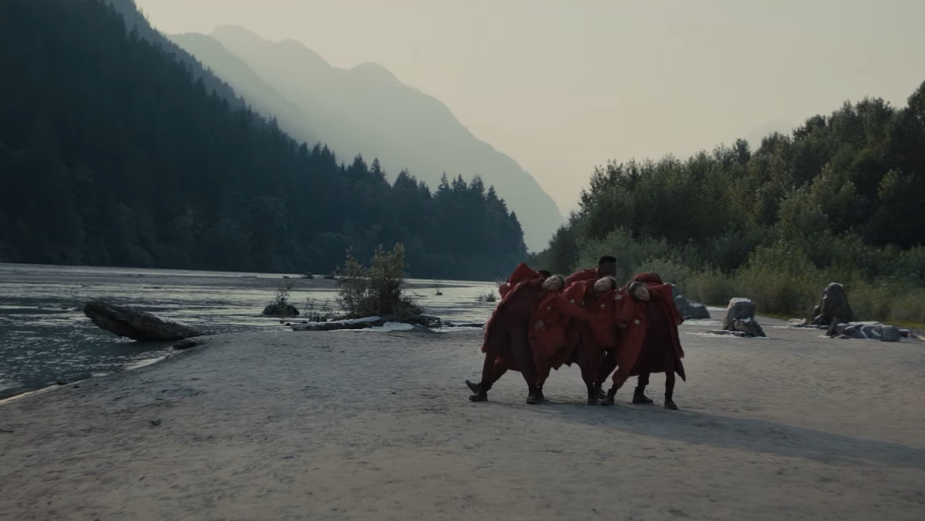
LBB> How did you incorporate the lululemon clothing into the film?
Natalie> The parka seemed to be the way into the whole idea. Rather than trying to fit the product in here and there - like many commercials do - why not make it the central idea? Feeling the jacket is to feel Canada. The dancers moving in the lululemon jackets embody our evolving identity. It was one of those lucky times where the product, the idea and the emotion are all tied together.
LBB> What was the hardest challenge you faced on this project, and how did you overcome it?
Natalie> Shooting in Vancouver in August for winter was a tough challenge. It was a long weekend, and we couldn’t shoot on a glacier. Because of the holiday, most of the public parks were closed for shooting to be open for tourists, so it was hard to find locations, which were so essential. And we had to shoot everyone in winter parkas in the scorching summer heat and hope no one could see the sweat dripping down their faces!
LBB> Anything else to add?
Natalie> Just a massive thank you to everyone who worked so tirelessly over this film for an over six-month production and to the collaborative spirit of the Droga5 team: Mike Hasinoff, Tim Gordon, Thom Glover, Marybeth Ledesma, Temnete Sebhatu, Joe Russomano, Gulshan Jaffery and many others!
And to my production companies, Object & Animal and OPC, for their unwavering support and passion for the project; my O&A EPs Emi Stewart, James Cunningham, Justin Benoliel, Morgan Clement and Dom Thomas; and, from OPC, Harland Weiss and my line producer Ed Callaghan; my DP Evan Prosofsky; choreographer Carlo Atienza and OURO Collective; my second-unit director Sophia Smith; Tim Myles; and my second-unit DP Ben Dawsen.
Thanks as well to my talented post collaborators: editor Ben Jordan and his team at Work Editorial, Ballad, Alter Ego and MPC colourist Ricky Gausis. All brought a level of detail and care to this film that made it so special.










